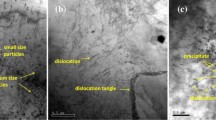Abstract
In this paper, the thermodynamic model of nitrogen solubility in vanadium nitrogen microalloyed high strength weathering steels of Fe–Cr–Mn–V–N system, according to Hillert’s model for Gibbs energy of its various phases, was established and validated. In the model, the effect of the nitrogen partial pressure on the activity coefficient and the lattice structure characteristics of the vanadium nitrogen precipitated phase were considered. It would be of guiding significance for the design and smelting of Fe–Cr–Mn–V–N system alloys. Based on the established model, the nitrogen contents in \(\delta\), \(\gamma\), \(\alpha\) phase and liquid were calculated as a function of the temperature for Fe–Cr–Mn–V–N system alloys. The results show that: first, the maximum solubility of nitrogen in the solidification process is obviously affected by the phase transition when there is a sudden change in the solubility of nitrogen at the phase transition point. The maximum nitrogen solubility of the molten steel in the delta phase region determines whether nitrogen bubbles are formed during the solidification process. The nitrogen solubility is lowest in the solid–liquid region (about 1673 K). Secondly, the increase of Cr and Mn content is beneficial to improve nitrogen solubility in liquid and solid phases. However, the increase of V content mainly affects the nitrogen solubility in the solid phase because the nitrogen in this temperature range is precipitated in the form of vanadium nitride, as the second phase plays a role in strengthening. In addition, the alloying element Mn has a significant effect on nitrogen solubility since the Mn element is the promoting element of austenitic formation. During the solidification process, the delta ferrite region gradually reduces and may disappear with increasing Mn content. Therefore, increasing the Mn content of the alloy system in the design of alloy composition, can reduce the precipitation trend of the nitrogen during the solidification process, which can effectively avoid bubble formation in high nitrogen weathering steels. Lastly, with the increase in the nitrogen partial pressure, the solubility of nitrogen increases during the liquid and solid phases.






Similar content being viewed by others
References
Andrew J, Iron and Nitrogen, The Iron and Steel Institute, London, VII (1912).
Adcock F, J Iron Steel Inst 114 (1926) 117.
Perez N, Electrochemistry and Corrosion Science, Springer, Berlin (2004).
Li H B, Jiang Z H, Shen M H, and You X M, J Iron Steel Res Int 14 (2007) 64.
Makaya A, and Fredriksson H, Sci Eng A 413 (2007) 533.
Adrian H, Mater Sci Technol 8 (1992) 406.
Kowanda C, Stickstofflöslichkeit in nickel und nickel basis legierungen im schmelzflüssigen zustand unter erhöhtem stickstoffpartialdruck, Zürich (2000).
Wang W E, Kim Y S, and Hong H S, J Alloys Compd 308 (2000) 147.
Mancha H, Herrera-Trejo M, García G, Méndez M, and Ablitzer D, Mater Des 17 (1996) 103.
Kunze J, and Rothe I, Steel Res Int 65 (1994) 331.
Qiu C A, Metall Trans A 24 (1993) 629.
Ishii F, Banya S, and Fuwa T, Tetsu- to- Hagane 68 (1982) 81.
Pomarin Y M, Grigorenko G M, and Lakomskiy V I, Russ Metall (1975) 61.
Kirchner G, Nishizawa T, and Uhrenius B, Metall. Trans. 4 (1973) 167.
Kobayashi T, Kuwana T, and Kiguchi R, J. Jpn. Weld. Soc. 41 (1972) 308.
Schürmann E, and Kunze H D, Steel Res Int 38 (1967) 585.
Dodd R A, and Gokcen N A, Trans. Metall. Soc. Aime 221 (1961) 233.
Jiang Z H, Zhu H C, and Li H B, Int Symp Liq Met Process Cast 2015 143 (2016) 12038.
Li G Q, Zhang F, and Zhu C Y, J Wuhan Univ Sci Technol Nat Sci Ed 28 (2005) 115.
Fast J D, and Verrijp M B, Acta Metall 3 (1955) 203.
Åatröm HU, and Borelius G, Acta Metall 2 (1954) 547.
Qiu C A, Metall Trans A 24 (1993) 2393.
Zheng X H, Nitrogen solubility in iron-base alloys and powder metallurgy of high nitrogen stainless steels (1991).
Kunze J, Brož P, Sopoušek J, and Gruner W, Steel Res Int 67 (1996) 26.
Coutsouradis D, Materials for advanced power engineering 1994: proceedings of a conference held in Liège, Belgium, 3–6 October 1994, Springer (1994).
Ghali S, J Metall 2014 (2014).
Pehlke R D, and Elliott JF, Trans Am Inst Min Metall Eng 218 (1960) 1088.
Feichtinger H, Zheng X H, and Rennhard C, Steel Res Int 61 (1990) 26.
Grigorenko G M, and Pomarin Y M, Nitrogen and Hydrogen in Molten Metals and Alloys, CRC Press, Boca Raton (1990).
Chen J X, Handbook of Diagram and Data of Steelmaking, Metallurgical Industry Press, Beijing (1984).
Satirkolorz A H, and Feichtinger H K, Zeitschrift Fur Metallkunde 82 (1991) 689.
Chipman J, and Corrigan D A, Trans Metall Soc AIME 233 (1965) 1249.
Hillert M, and Staffansson L I, Acta Chem Scand 24 (1970) 3618.
Balachandran G, High Nitrogen Steels and Stainless Steelsmanuf Acturing, Properties and Applications, Alpha Science International Ltd, Pangbourne (2004) p 40.
Acknowledgements
This work was financially supported by the project of green manufacturing system integration of MIIT China (2016-64).
Author information
Authors and Affiliations
Corresponding author
Rights and permissions
About this article
Cite this article
Cheng, J., Shen, H. Research on Nitrogen Solubility of Fe–Cr–Mn–V–N System Alloys in Liquid and Solid Phases. Trans Indian Inst Met 71, 2433–2442 (2018). https://doi.org/10.1007/s12666-018-1374-0
Received:
Accepted:
Published:
Issue Date:
DOI: https://doi.org/10.1007/s12666-018-1374-0




